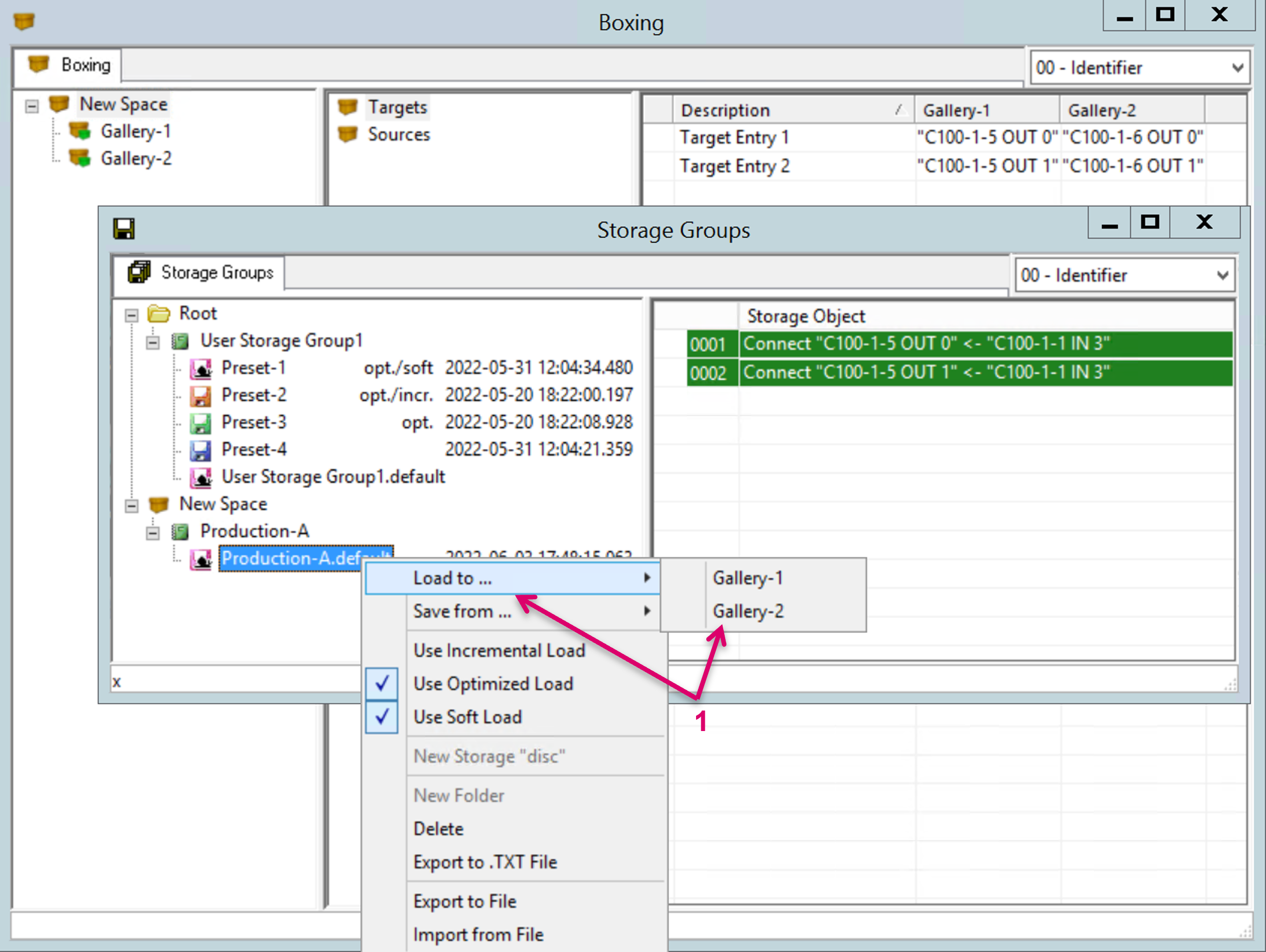vsmStudio - Storage Groups

Introduction
In vsmStudio, Storage Groups are designed to Save and Load defined presets. Each preset can contain Signal paths, GPOs, Gadget Parameters and even dynamic Button Assignments. This chapter covers the configuration of Storage Groups.
Although there is no specific limitation known in regards of the content related size per Storage Group and Storage “disc”, it is still recommended to use Storage Groups with consideration that loading a “huge” Storage “disc” may keep the system, as well as related controlled devices, busy for an undefined amount of time. In worse case this could result in delayed execution of included actions. Therefore, creating for instance one Storage Group, containing all system targets, parameters, etc. should be absolutely avoided.
Storage Group Window
Open the Storage Groups window via the respective icon in the main menu bar.
The Storage Groups window is divided into two parts, while the left side displays the actual Storage Group folders and underlying Storage Discs (1), all objects to store (2), plus their last stored state (3) are listed in the right section of the window. Initially, the Storage Group folder section is empty, except a folder Root (4).
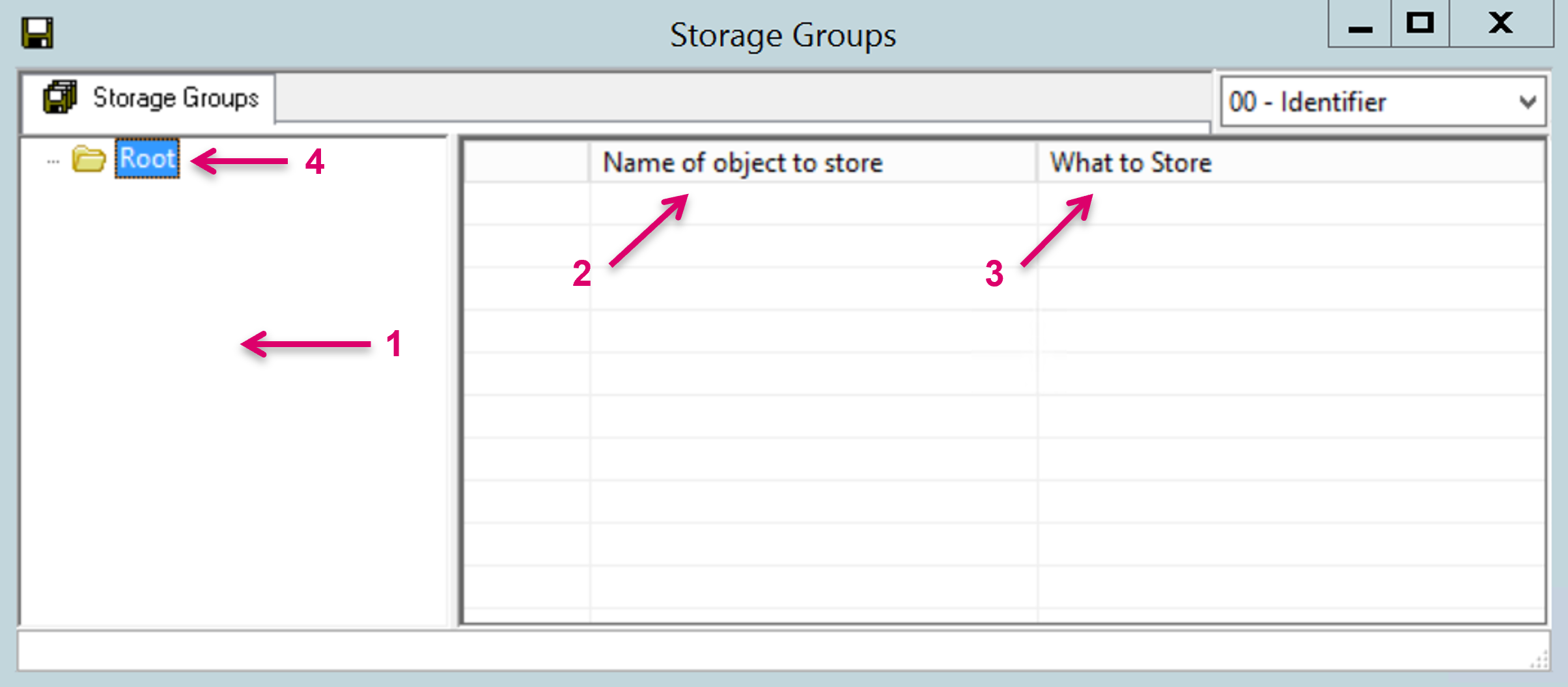
Create a new Storage Group
Storage Groups represent the collection of objects (Signal paths, GPOs and/or Gadget Parameters) that are included with a save and load action. To create a new Storage Group folder, right-click into the left section of the Storage Groups window and select New Folder (1).
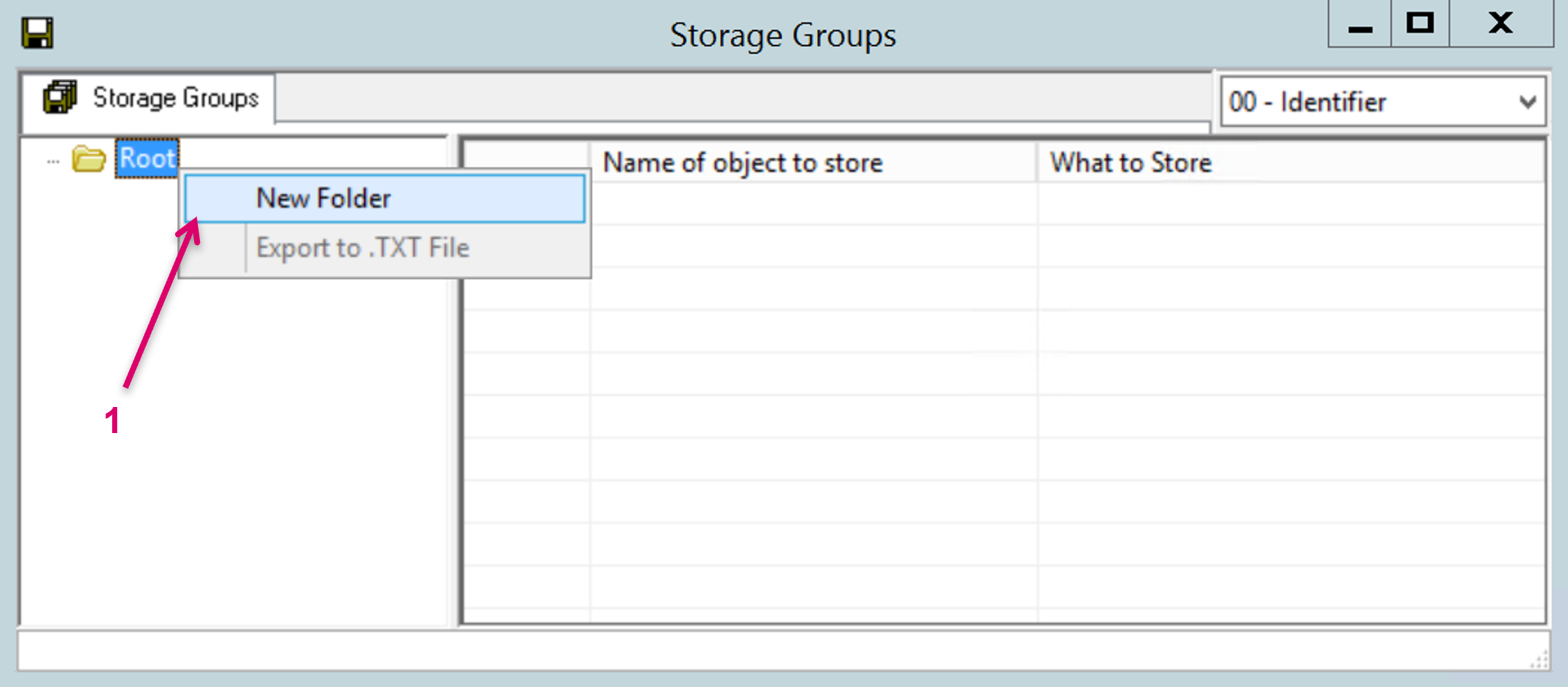
Change the name of a folder by left-click on the respective Storage Group (1).
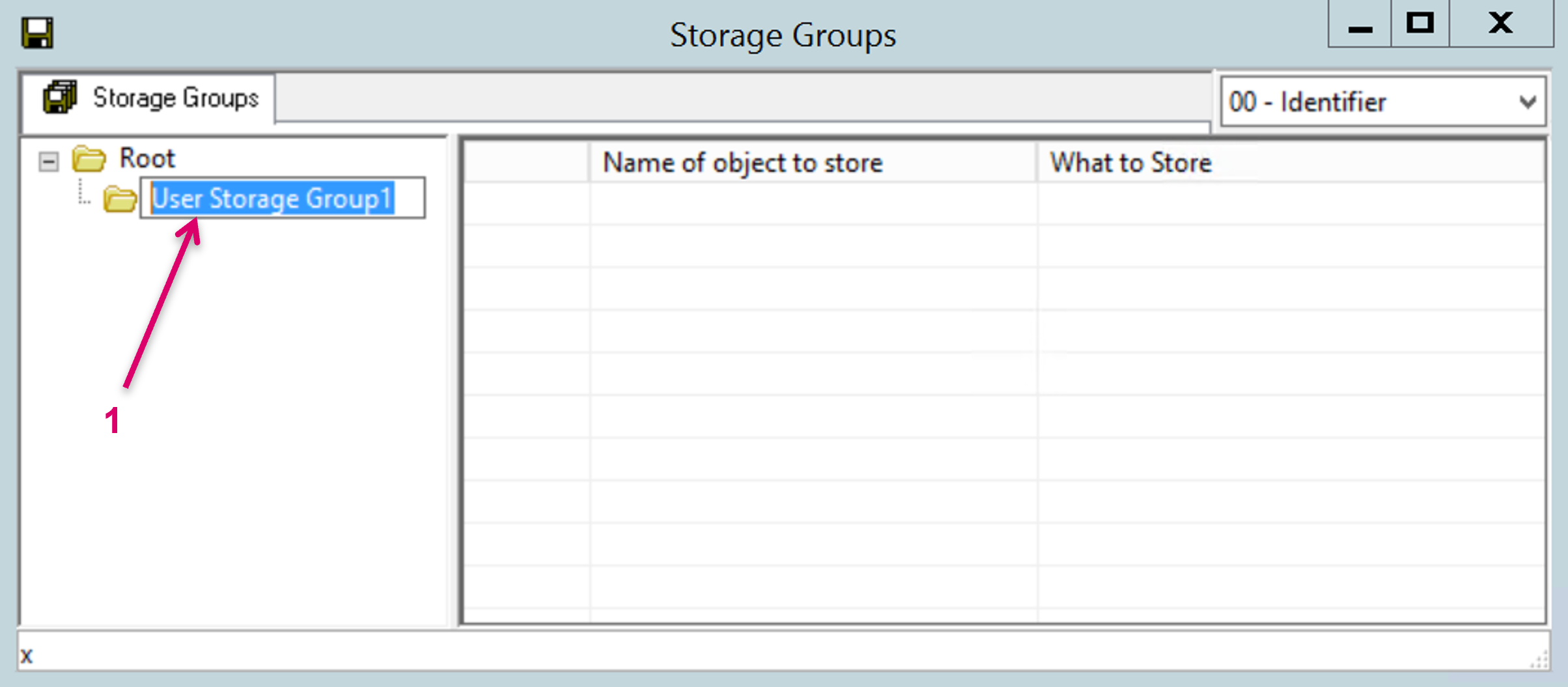
Define Objects to Store
To create the collection of objects (Signal paths, GPOs and/or Gadget Parameters) that will be included with a save and load action of Storage “discs”, simply drag & drop the respective essences on the Storage Group folder. Note that the folder icon changes after the first assignment (1).
Assign Signal Paths
Signal paths can be assigned to the Storage Group (1) by drag, either from the Signal Paths list (2), the Primary Virtual Matrix, or from any matrix View (3) and drop on the respective Storage Group folder.
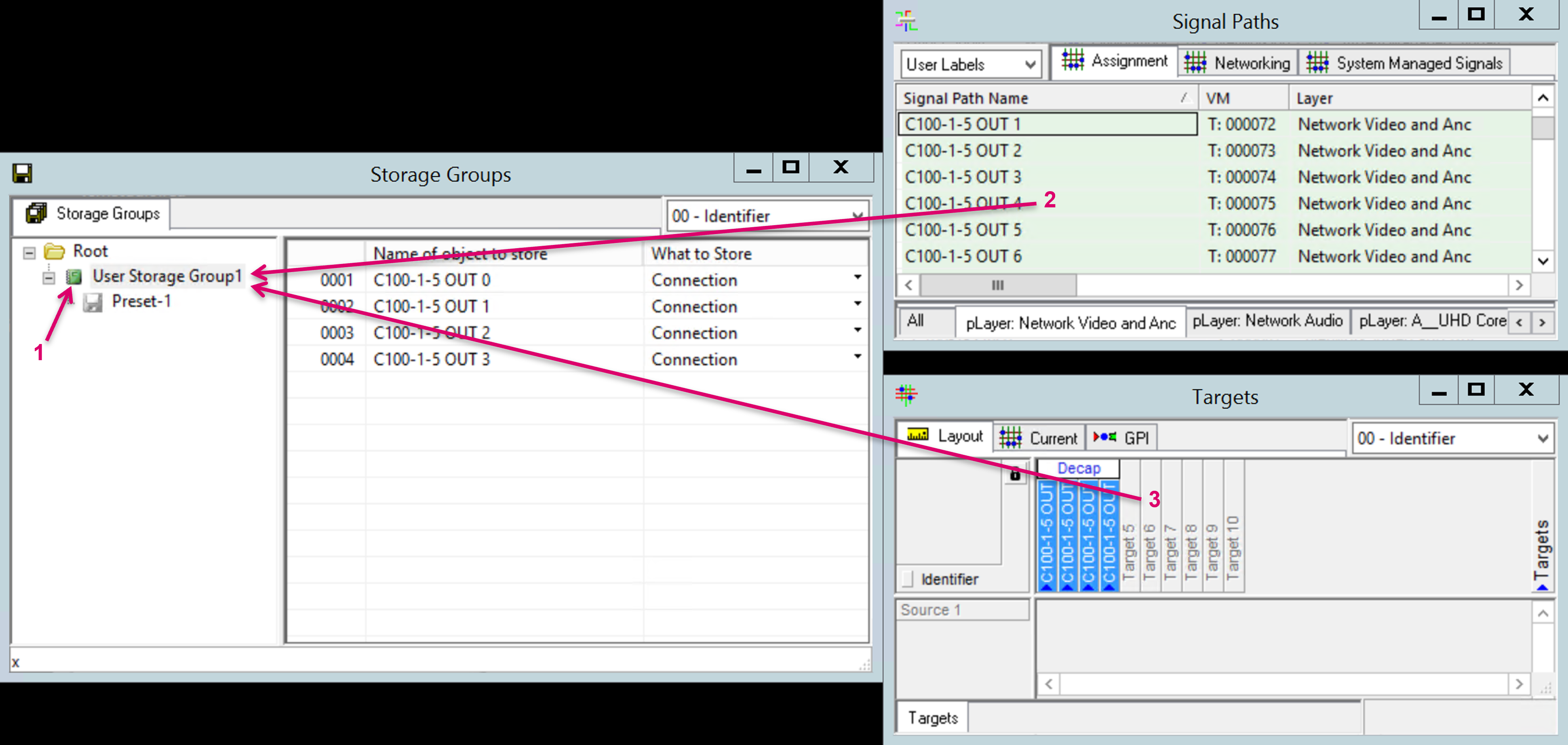
The column What to Store provides additional options via drop-down menu (1). By default, the option for dropped Signal paths is set to Connection.
Legend for the selectable options:
Connections (2): Save the current crosspoint state for a Target Signal path
Connected Targets of Source (Relative) (3): Save the current crosspoint state for all Targets that are connected to a Source Signal path
multiviewer – active layout (4): Save the active DMV Head layout, assigned to the respective Target Signal path. Only effective in combination with the Distributed Multi Viewer module
multiviewer – PIP sources (5): Save the crosspoint state of all PIPs that are currently active/displayed on the DMV head, assigned to the respective Target Signal path. Only effective combination with the Distributed Multi Viewer module
Label – xyz (6): Save a specific label of the respective Signal path. All label levels that got a user-defined name are listed here.
The displayed label selector in the right upper corner (7) is only effective on the Storage “discs” view.
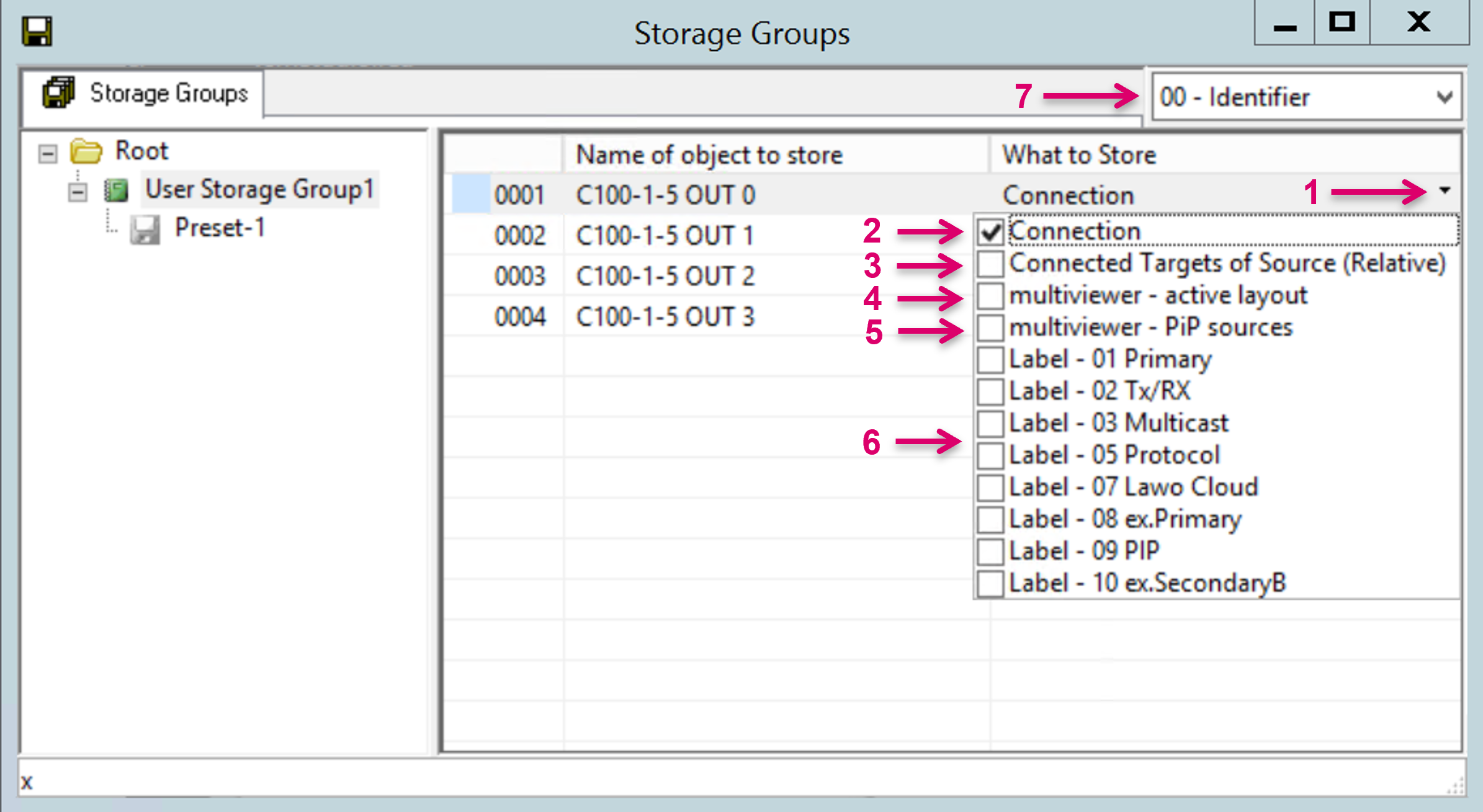
Assign GPO
GPOs can be assigned to the Storage Group by drag from the GPIs list (1) and drop on the respective Storage Group folder.

The column What to Store provides additional options for the following Save operations via drop-down menu (1). By default, the option for dropped Signal paths is set to State.
Legend for the selectable options:
State (2): Save the current true or false state of a GPO
Assignment (3): Save the current condition-assignment status of a GPO, that was dynamically assigned with the button-functions “Assign GPI to Switchable Node” ![]() , “Assign multiple GPI´s to GPO”
, “Assign multiple GPI´s to GPO” ![]() or “Assign Tally to GPO”
or “Assign Tally to GPO” ![]() via a VSM Panel.
via a VSM Panel.
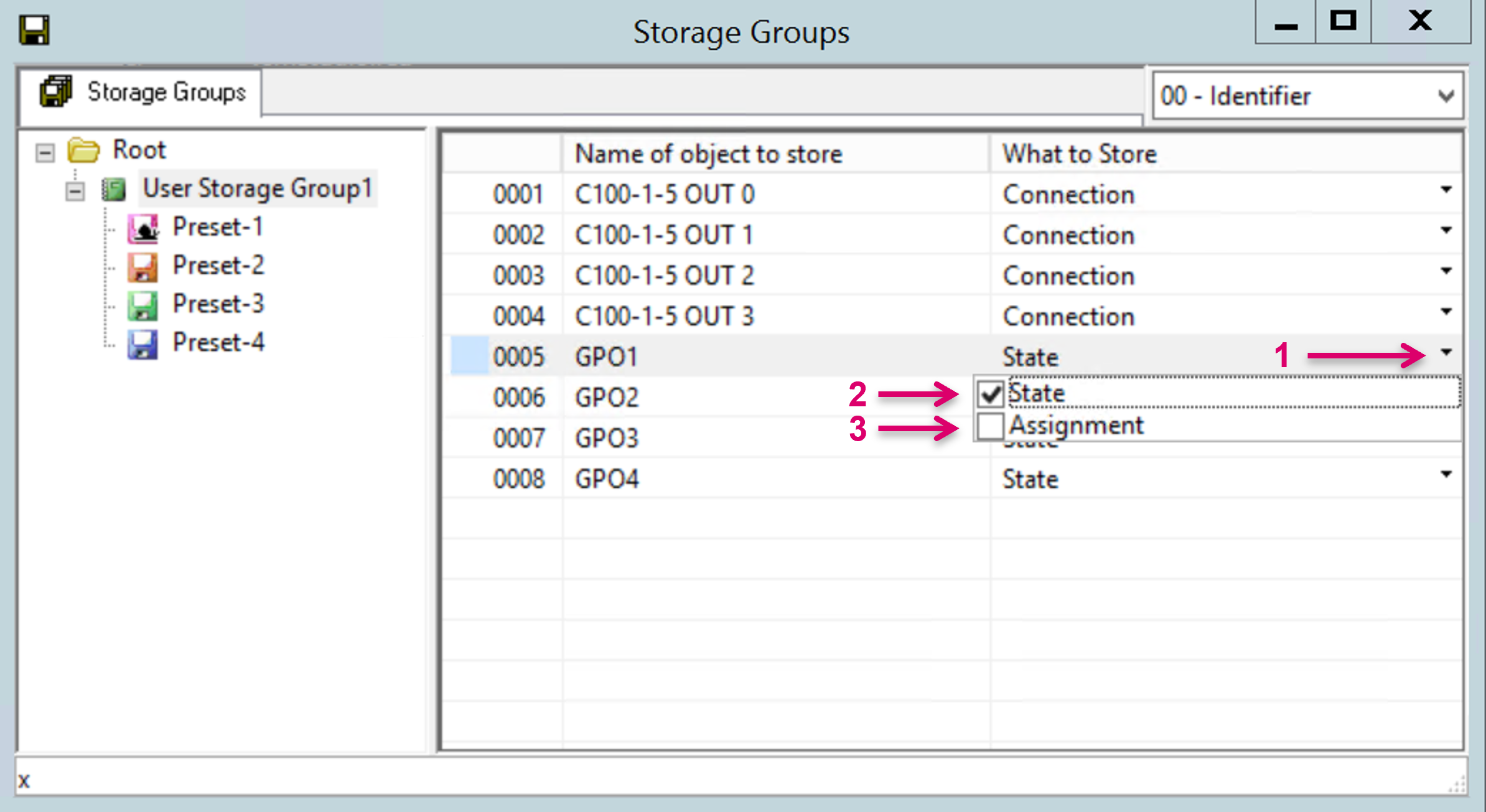 571
571
Assign Gadget Parameters
Gadget Parameters can be assigned to the Storage Group by drag from the Gadget Tree (1) and drop on the respective Storage Group folder. Values (2) will be stored accordingly.

If a Gadget Parameter, that is assigned to a storage group and Saved to a Storage "disc", is a simple "command" that effectively toggles a state, the resulting state following a Load action cannot be determined. E.g. if the parameter triggers/toggles an on/off state, the result could be on OR off, dependent on the current parameter state at time of executing the Load action.
Assign Panel (Button Assignments)
It is also possible to save dynamic button assignments, done via Mimic buttons or the “User Assignable” on Page button feature (1).
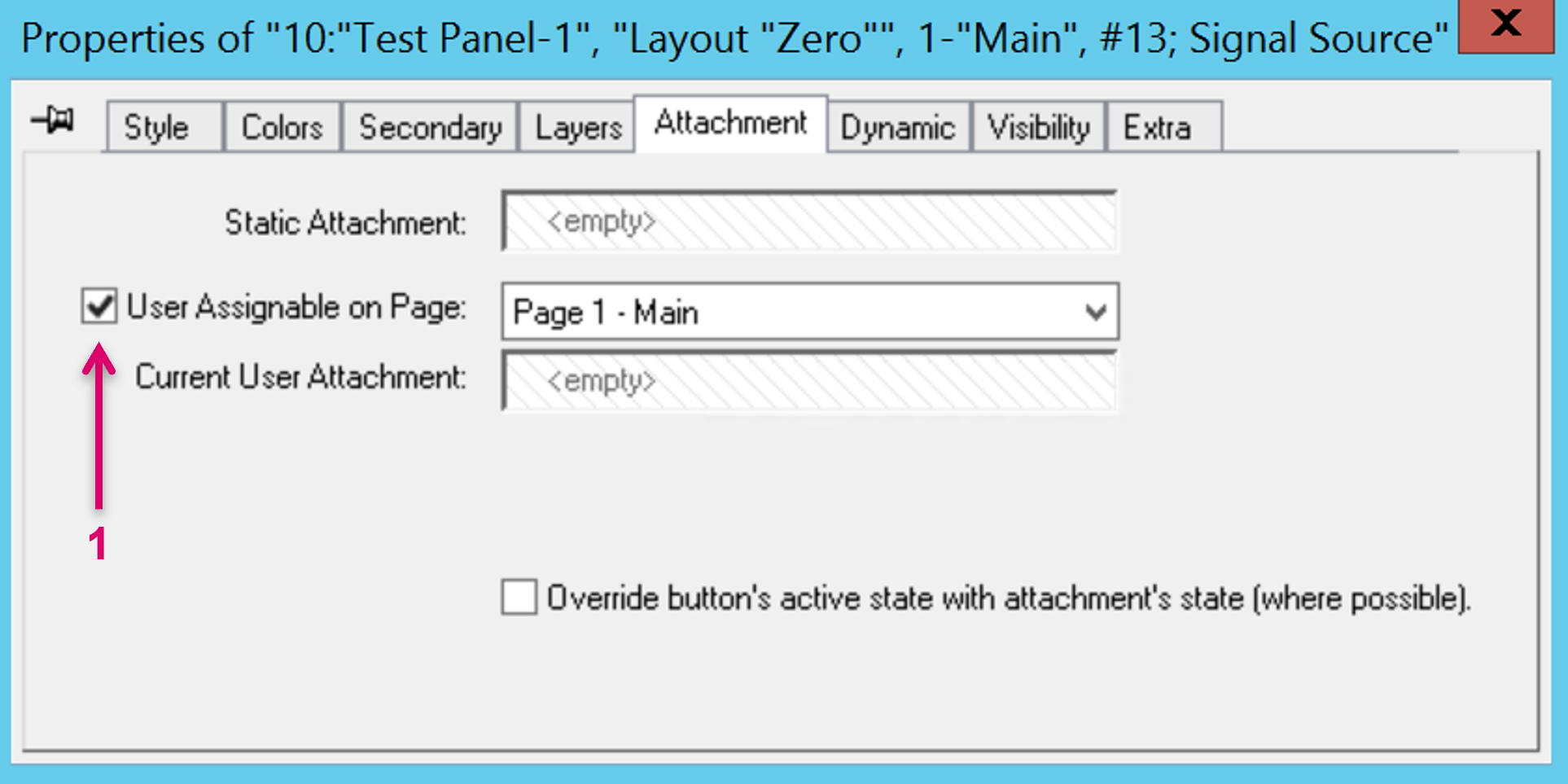
Panels can be assigned to the Storage Group by drag from the Panel List (1) and drop on the respective Storage Group folder. Mimic Buttons and button User Assignments (2) will be stored accordingly.

Create a new Storage "disc"
A Storage “disc” represents one snapshot with stored status of all objects (Signalpaths, GPOS and/or Gadget Parameters) that are defined in the respective Storage Group. One or multiple Storage Disc must be created per Storage Group in order to save and load a Snapshot.
To create a new Storage Disc, right-click on the respective Storage Group, and select Storage “disc” (1).
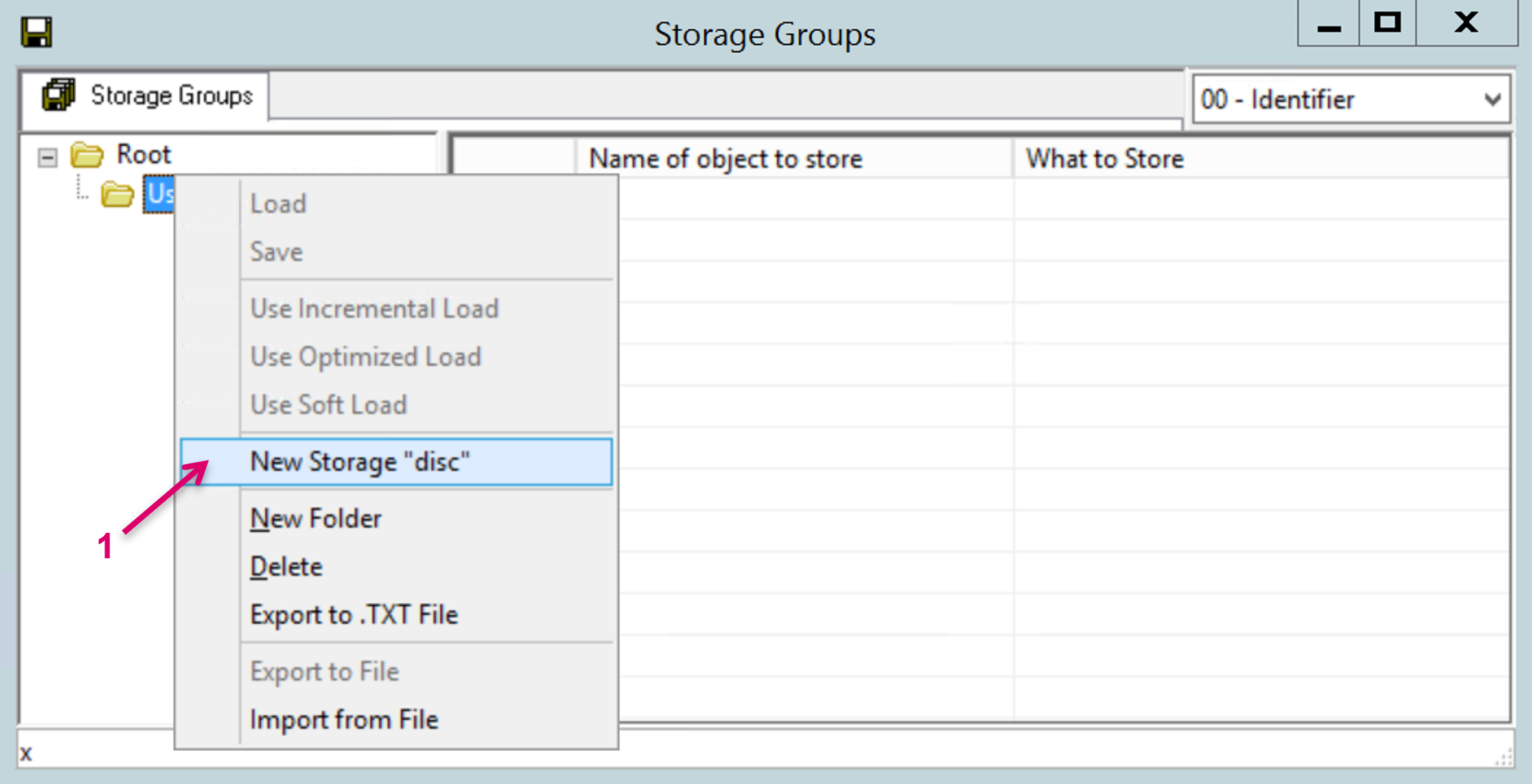
Enter a name for the Storage disc (1).
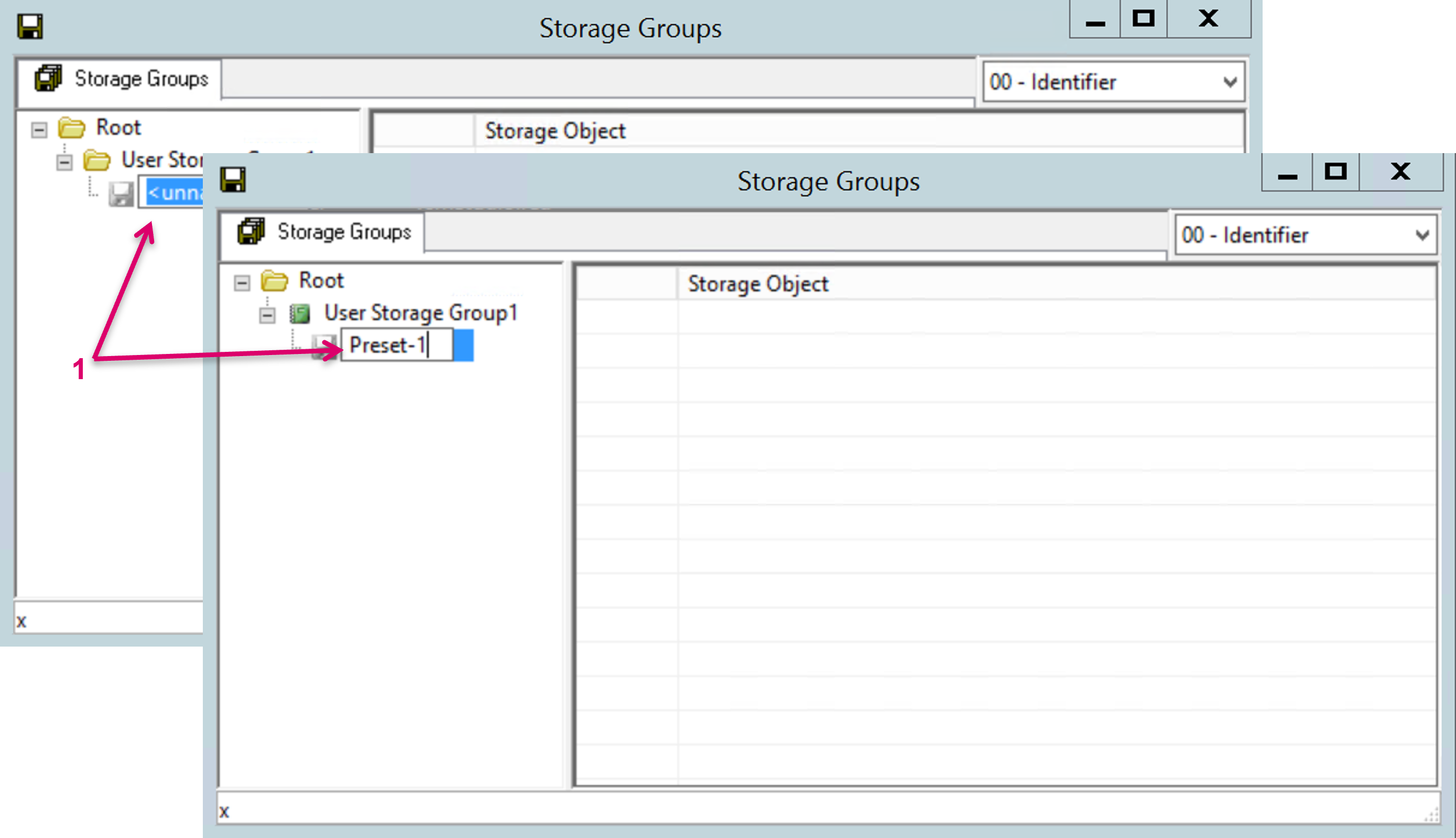
In addition, it is also possible to create Storage Group subfolders (1) to group and organize Storage “discs”. Right-click on the respective Storage Group and select New Folder (2).
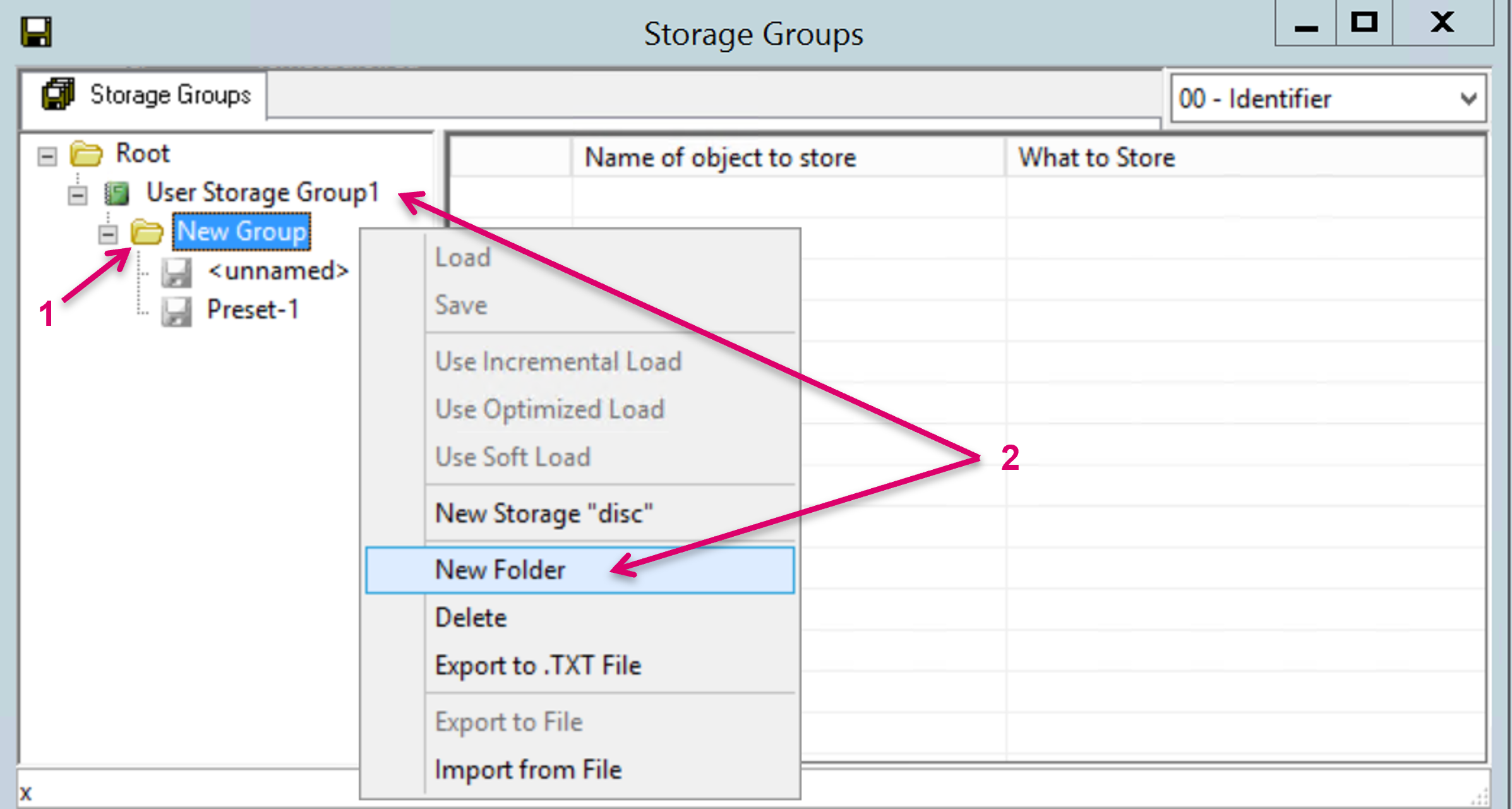
Storage “discs” can easily be moved between folders by drag & drop action.
Moving a Storage “disc” from one Storage Group to another, where the target Storage Group has a different set of assigned objects, the disc may still be loaded with the last stored content, but all its content will be overwritten with the object status related to the now actual Storage Group on any following Save action.
Save to a Storage "disc"
To save a current snapshot of pre-set Crosspoints, values and assignments to a specific Storage “disc”, right-mouse-click on the relevant Storage “disc” and select the option Save from the drop-down menu (1). Subsequently, a pop-up window opens, requesting the confirmation for the Save action. Select Yes to confirm or No to abort the Save action (2). If executing the Save action directly via the Storage Group node, a Storage “disc” with respective filename and ending .default is created automatically (3). Once this .default “disc” was created initially, it will be overwritten if the Storage Group Save is executed the next time. Date and time of the last Save are indicated per Storage “disc” (4). The stored content of the selected Storage “disc” is displayed in the Storage Object window. The green background color on Crosspoint and GPO states indicates that the displayed state already is the current object state (5).
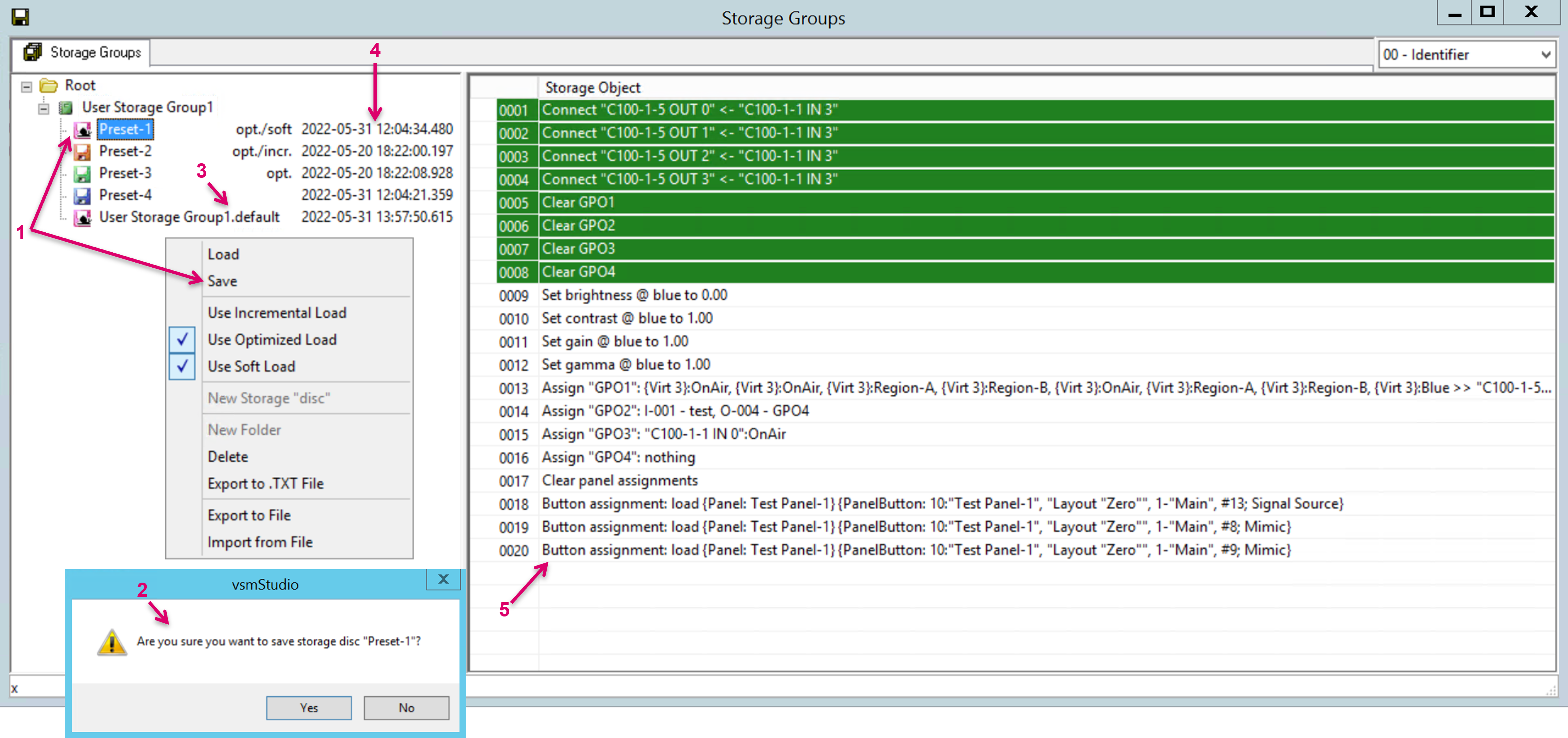
Load a Storage "disc" and Load Options
To load a current snapshot of pre-set Crosspoints, values and assignments from a specific Storage “disc”, right-mouse-click on the relevant Storage “disc” and select the option Load from the drop-down menu (1). Subsequently, a pop-up window opens, requesting the confirmation for the Load action. Select Yes to confirm or No to abort the Load action.
Various Load options are available. Based on the selected option, the Disc symbol is presented differently as well.
Incremental Load: Only perform (connect) operations that are not already connected
Optimized Load: Operations are reordered to increase the chance for success, in the following order:
- All targets with no source or assigned to Blind (disconnect) source
- All virtual targets
- All targets which will be disconnected
- All targets which are to be connected on same layer
- Everything that might use a Tie-line. This ensures that tie-lines can be freed before they are needed
- All remaining actions
Soft Load: Load storage group entries when nothing more important is pending from system perspective.
Please be aware that the option Incremental does not consider any secondary conditions or dependencies, e.g., pseudo rules.
The default setting is Use Optimized Load and Use Soft Load (2).

If a Gadget Parameter, that is assigned to a storage group and Saved to a Storage "disc", is a simple "command" that effectively toggles a state, the resulting state following a Load action cannot be determined. E.g. if the parameter triggers/toggles an on/off state, the result could be on OR off, dependent on the current parameter state at time of executing the Load action.
Export and Import
It is possible to export the data content of the Storage Group or a Storage “disc” to a simple text file. To do so, right-mouse-click on a Storage “disc” and select Export to .TXT File from the drop-down menu to export the content of the specific “disc” only. Do the same action on the Storage Group node to export the data of the node including all underlying “discs” (1). Select a file name and target file location to finalize the export (2). Exported text files cannot be used for import.
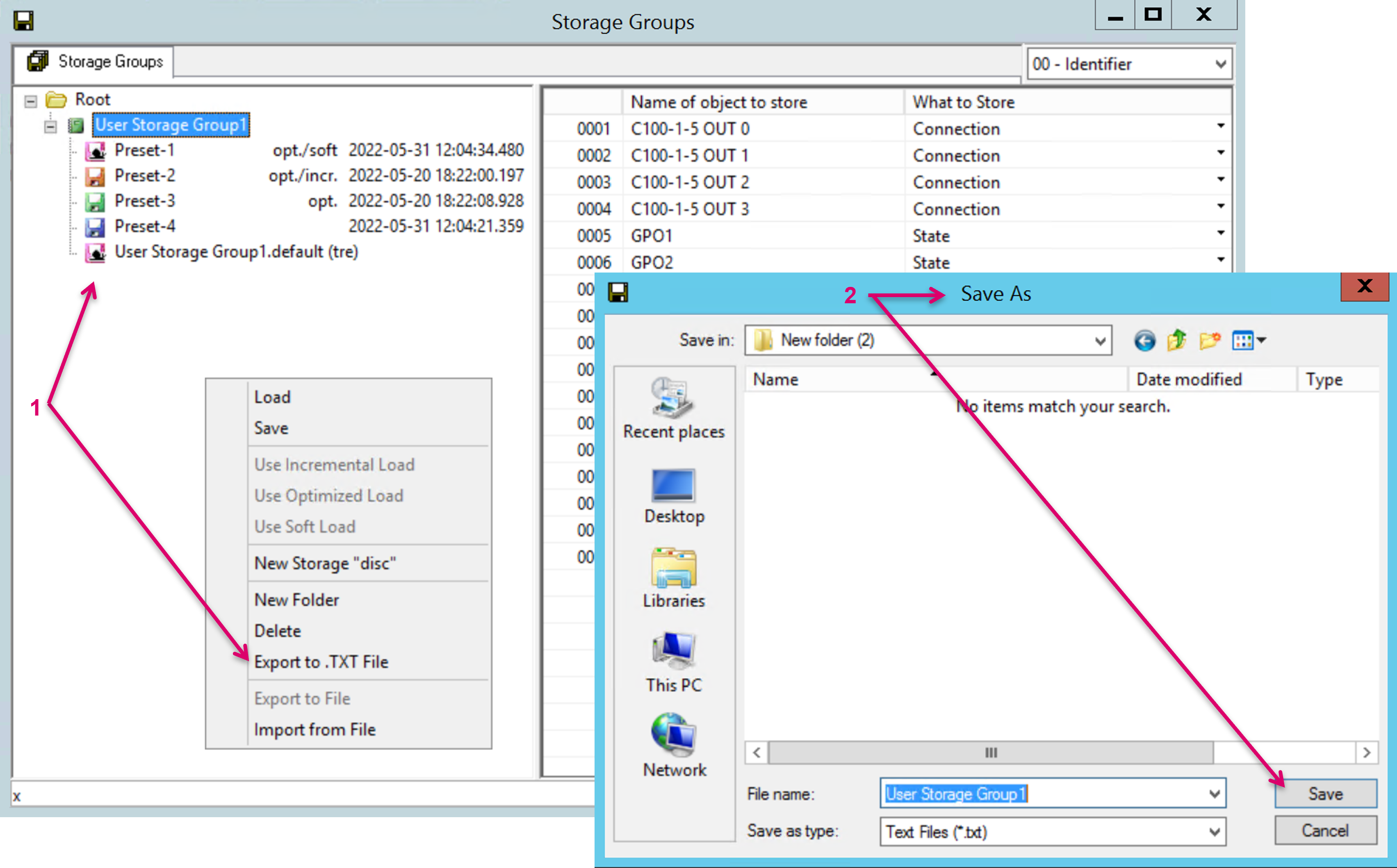
Storage “discs” can also be exported to file. This file type can be imported into a vsmStudio configuration. Since the content of a Storage “disc” is related to specific resources and configuration details, it may only make sense to import Storage “discs” into configuration files with the identical configuration basis. To export, right-mouse-click on a Storage “disc” and select Export to File from the drop-down menu (1). Select a file name and target file location to finalize the export (2). Follow the same procedure for a Storage “disc” Import from File.
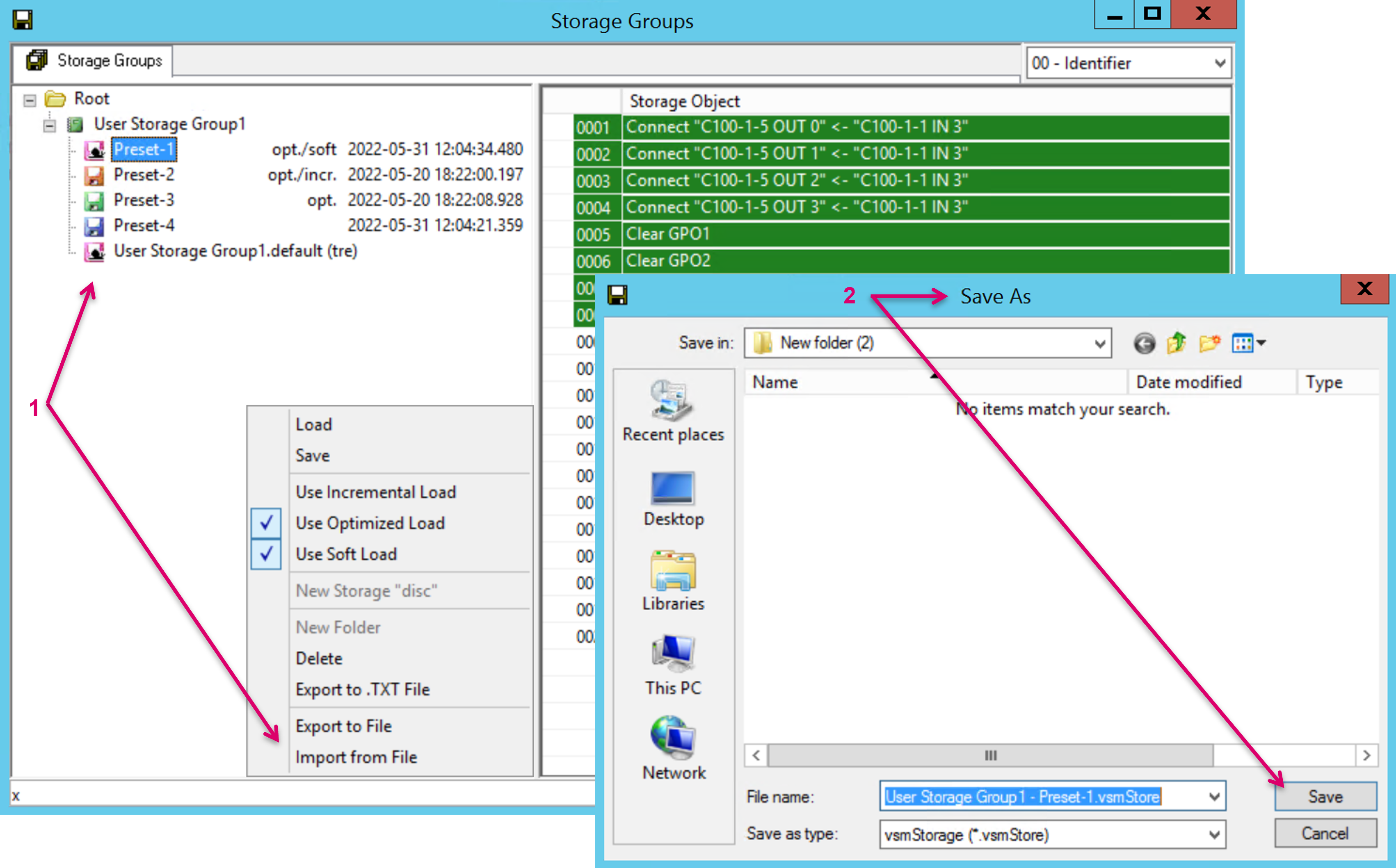
Deleting Storage Groups or Content
If a Storage Group or Storage “disc” is no longer needed, they can be deleted by right-mouse-click selection and option Delete. Storage Objects can even be multiselected via right-mouse-click and option Delete.
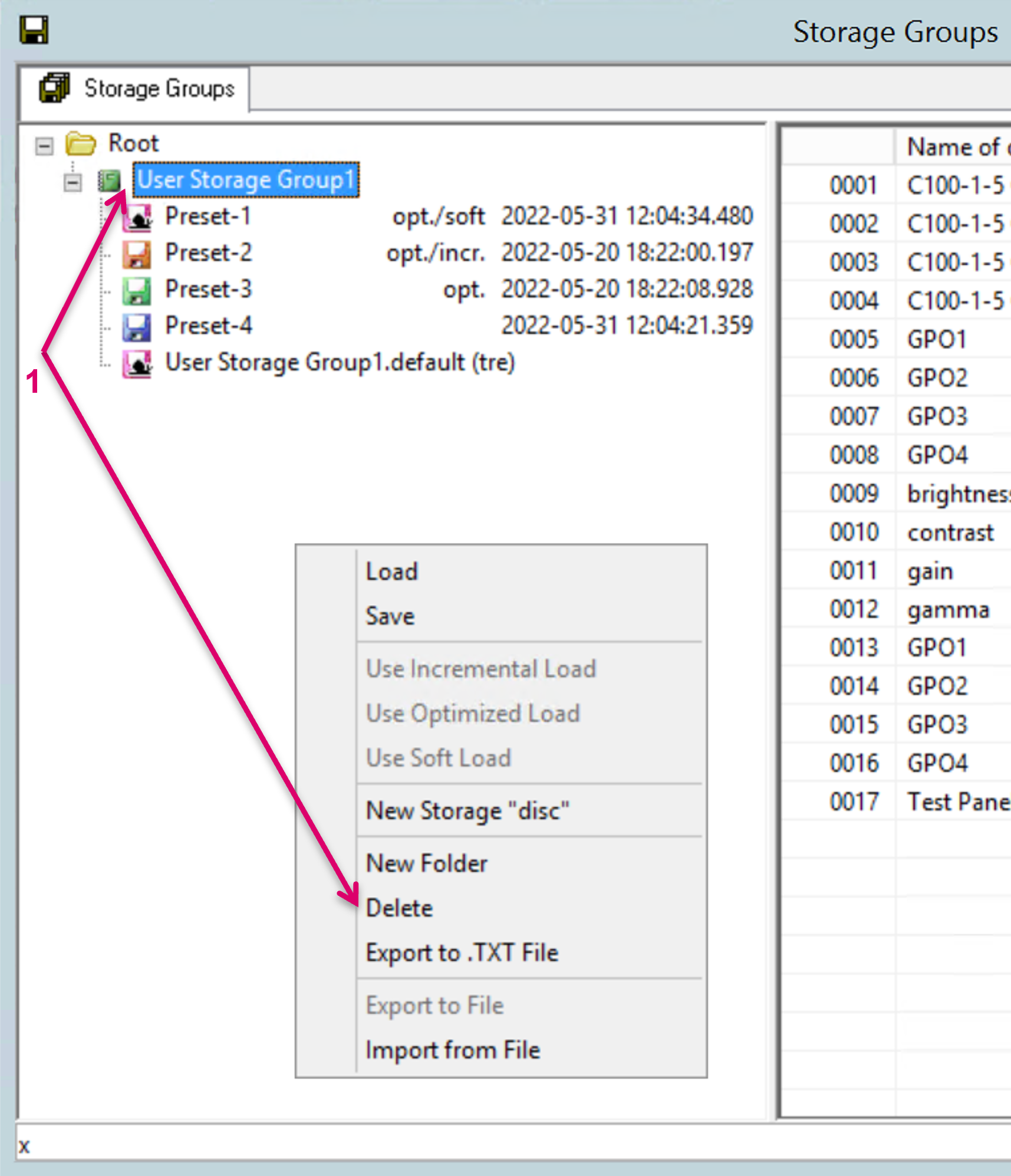
Storage Groups as part of Boxing Feature
Storage Groups are an essential part of the Boxing feature in vsmStudio (1). If this feature is used, a dedicated Storage Group folder is created by the system automatically (2).
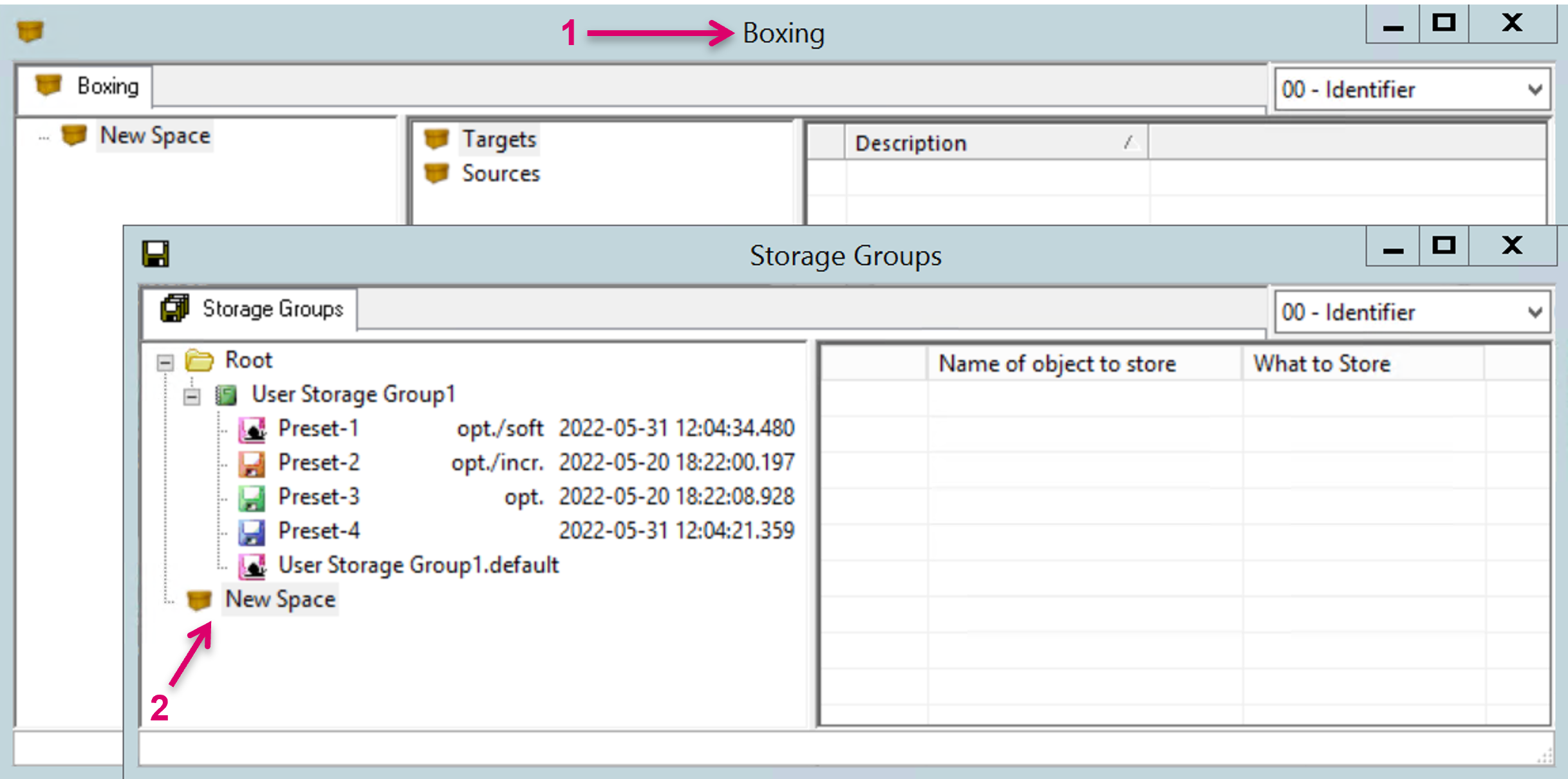
Storage Groups still need to be created manually under the Boxing node, that for instance, may represent a Scene or Production (1). Drag and drop respective Objects to Store in the same process as described further above on the created Storage Group (2).

The Save and Load behavior and options of Storage “disc” is slightly different under the Boxing node. The idea of Boxing is to Save the current Object state from one “Box” and Load it to another. Therefore, it is required to select the respective source and destination “Box” from the drop-down menu to execute the Save and Load action (1).
